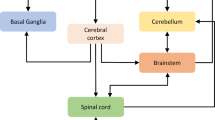Abstract
In earlier papers, we have proposed the feedback-error-learning of inverse dynamics model of the musculoskeletal system as heterosynaptic learning scheme in the cerebrocerebellum and the parvocellular part of the red nucleus system, and the iterative learning in the parietal association cortex. In this paper, we applied hierarchical arrangement of these two neural network models to learning trajectory control of an industrial robotic manipulator. We found that the hierarchical arrangement of the cerebellar and cerebral neural networks not only increased control stability but also dramatically improved accuracy of control and reduced required learning time.
Access this chapter
Tax calculation will be finalised at checkout
Purchases are for personal use only
Preview
Unable to display preview. Download preview PDF.
Similar content being viewed by others
References
G.I. Allen and N. Tsukahara, “Cerebrocerebellar communication systems,” Physiol Rev., vol.54, pp. 957–1006, 1974.
P.D. Cheney and E.E. Fetz, “Functional classes of primate corticomotoneuronal cells and their relation to active force,” J. Neurophysiol. vol.44, pp. 773–791,1980.
T. Flash and N. Hogan, “The coordination of arm movements; An experimentally confirmed mathematical model,” J. Neurosci., vol. 5, pp. 1688–1703, 1985.
S. Geman, “Some averaging and stability results for random differential equations,” SIAM J. Appl. Math., vol. 36, pp. 86–105, 1979.
M. Ito, “Neurophysiological aspects of the cerebellar motor control system,” Intern. J. Neurol, vol.7, pp. 162–176, 1970.
M. Kawato, T. Hamaguchi, F. Murakami and N. Tsukahara, “Quantitative analysis of electrical properties of dendritic spines,” Biol Cybern., vol. 50, pp. 447–454, 1984.
M. Kawato, H. Miyamoto, M. Isobe and R. Suzuki, “Learning control of hand in task-oriented coordinate by iteration — a Newton-like algorithm —,” Japan IECE Technical Report, vol.MBE85-91, pp.83–92, (in Japanese) 1986.
M. Kawato, K. Furukawa and R. Suzuki, “A hierarchical neural-network model for control and learning of voluntary movement,” Biol Cybern., vol. 57, pp. 169–185, 1987.
M. Kawato, “Adaptation and learning in control of voluntary movement by the central nervous system,” Advanced Robotics, vol. 2, in press, 1988.
M. Kawato, M. Isobe, Y. Maeda and R. Suzuki, “Coordinates transformation and learning control for visually-guided voluntary movement with iteration: A Newton-like method in a function space,” Biol. Cybern., in press, 1988.
M. Kawato, Y. Uno, M. Isobe and R. Suzuki, “A hierarchical neural network model for voluntary movement with application to robotics,” IEEE Control Systems Magazine, in press, 1988.
H. Miyamoto, M. Kawato, T. Setoyama and R. Suzuki, “Feedback-error-learning neural network for trajectory control of a robotic manipulator,” Neural Networks, in press, 1988.
T. Poggio and V. Torre, “A theory of synaptic interactions,” In: Theoretical Approaches in Neurobiology, pp. 28–46, Reichardt, W.E., Poggio, T., eds. Cambridge: MIT Press, 1981.
D. Psaltis, A. Sideris and A. Yamamura, “Neural controllers,” Proc. IEEE 1st Int. Conf. Neural Networks, San Diego, USA., June 21-24, vol. IV, pp. 551–558, 1987.
D.E. Rumelhart, “Learning sensorimotor programs in parallel distributed processing systems,” this proceedings, 1988.
T. Setoyama, M. Kawato and R. Suzuki, “Manipulator control by inversedynamics model learned in multi-layer neural network,” Japan IEICE Technical Report, vol. MBE87, (in Japanese) 1988.
N. Tsukahara and M. Kawato, “Dynamic and plastic properties of the brain stem neuronal networks as the possible neuronal basis of learning and memory,” In: Competition and Cooperation in Neural Nets. pp. 430–441, Amari, S., Arbib, M.A. eds., New York: Springer, 1982.
Y. Uno, M. Kawato and R. Suzuki, “Formation and control of optimal trajectory in human multijoint arm movement — minimum torque-change model —,” Biol. Cybern., submitted, 1988.
Author information
Authors and Affiliations
Editor information
Editors and Affiliations
Rights and permissions
Copyright information
© 1989 Springer-Verlag New York Inc.
About this paper
Cite this paper
Kawato, M., Isobe, M., Suzuki, R. (1989). Hierarchical Learning of Voluntary Movement by Cerebellum and Sensory Association Cortex. In: Arbib, M.A., Amari, Si. (eds) Dynamic Interactions in Neural Networks: Models and Data. Research Notes in Neural Computing, vol 1. Springer, New York, NY. https://doi.org/10.1007/978-1-4612-4536-0_12
Download citation
DOI: https://doi.org/10.1007/978-1-4612-4536-0_12
Publisher Name: Springer, New York, NY
Print ISBN: 978-0-387-96893-3
Online ISBN: 978-1-4612-4536-0
eBook Packages: Springer Book Archive




